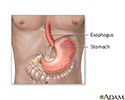Bernstein test
Acid perfusion test
The Bernstein test is a method to reproduce symptoms of heartburn . It is most often done with other tests to measure esophageal function.
Heartburn
Heartburn is a painful burning feeling just below or behind the breastbone. Most of the time it comes from the esophagus. The pain often rises in y...

Esophageal function.
Esophageal manometry is a test to measure how well the esophagus is working.

How the Test is Performed
The test is done in a gastroenterology laboratory. A nasogastric (NG) tube is passed through one side of your nose and into your esophagus. Mild hydrochloric acid will be sent down the tube, followed by salt water (saline) solution. This process may be repeated several times.
You will be asked to tell the health care team about any pain or discomfort you have during the test.
How to Prepare for the Test
You should not eat or drink anything for 8 hours before the test.
How the Test will Feel
You may have a gagging feeling and some discomfort when the tube is put in place. The acid may cause symptoms of heartburn. Your throat may be sore after the test.
Why the Test is Performed
The test tries to reproduce symptoms of gastroesophageal reflux (stomach acids coming back up into the esophagus). It is done to see if you have the condition.
Gastroesophageal reflux
Gastroesophageal reflux disease (GERD) is a condition in which the stomach contents leak backwards from the stomach into the esophagus (the tube from...

Normal Results
The test results will be negative.
What Abnormal Results Mean
A positive test hows that your symptoms are caused by esophageal reflux of acid from the stomach.
Risks
There is a risk of gagging or vomiting.
References
Fass R, Achem SR Noncardiac chest pain: diagnostic evaluation. Dis Esophagus . 2012 Feb;25(2):89-101. PMID: 21777340 www.ncbi.nlm.nih.gov/pubmed/21777340 .
Kahrilas PJ, Pandolfino JE. Esophageal neuromuscular function and motility disorders. In: Feldman M, Friedman LS, Brandt LJ, eds. Sleisenger and Fordtran's Gastrointestinal and Liver Disease . 9th ed. Philadelphia, PA: Elsevier Saunders; 2010:chap 42.
-
Stomach and stomach lining - illustration
The stomach connects the esophagus to the small intestines and is where the majority of food digestion takes place.
Stomach and stomach lining
illustration
Review Date: 11/20/2014
Reviewed By: Jenifer K. Lehrer, MD, Department of Gastroenterology, Frankford-Torresdale Hospital, Aria Health System, Philadelphia, PA. Review provided by VeriMed Healthcare Network. Also reviewed by David Zieve, MD, MHA, Isla Ogilvie, PhD, and the A.D.A.M. Editorial team.

